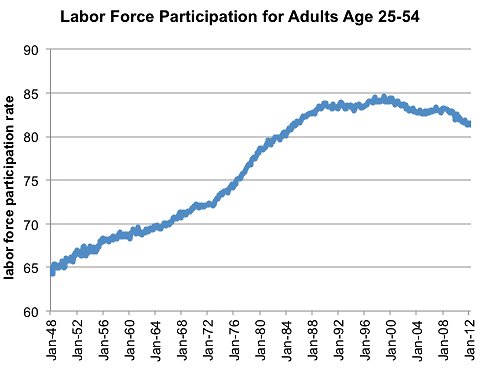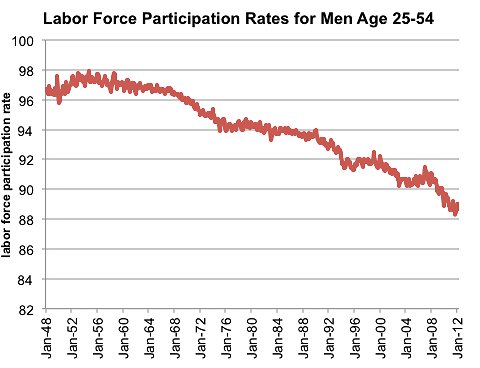Among
the lowlights of the jobs report for April
was the news that the share of adults who
are either working or looking for work
fell. For men, this measure — called the
labor force participation rate — was at
its lowest level since 1948, when the
government first began keeping track.
I’ve received a number of
e-mails from readers asking whether this
decline can be attributed to the wave of
baby-boomer retirements.
Yes, as America ages, its
overall labor force participation rate
will fall because older people are less
likely to work. But even excluding older
Americans, labor force participation rates
have still fallen sharply over the last
few decades, and especially in the last
five years.
This chart shows the share
of Americans 25 to 54 years old who are
involved in the labor force, either by
working or actively looking for work:

Source: Bureau of
Labor Statistics
As you can see, this age
group is also dropping out of the labor
force. The participation rate fell after
the 2001 recession, never recovered, and
then started another slide that began in
the financial crisis. This trend among
prime-working-age Americans cannot be
explained by baby boomers’ retiring.
You may notice that the
labor force participation rate had been
climbing from the 1940s through about
1990. That rise reflects the fact that
more women entered the labor force as
gender roles evolved. Women’s labor force
participation rate continued rising
through the late 1990s, dropped a couple
of percentage points, and then more or
less flat-lined.
The main reason the labor
force has been declining in the last
couple of decades, then, is that men have
been dropping out in droves. Here is a
chart of labor force participation for
workers 25 to 54, but showing men only:

Source: Bureau of
Labor Statistics
Where
are all these men going, and how are they
supporting themselves, if they’re not in
the work force? My colleagues David
Leonhardt and Louis Uchitelle looked into
this question a few years ago.



